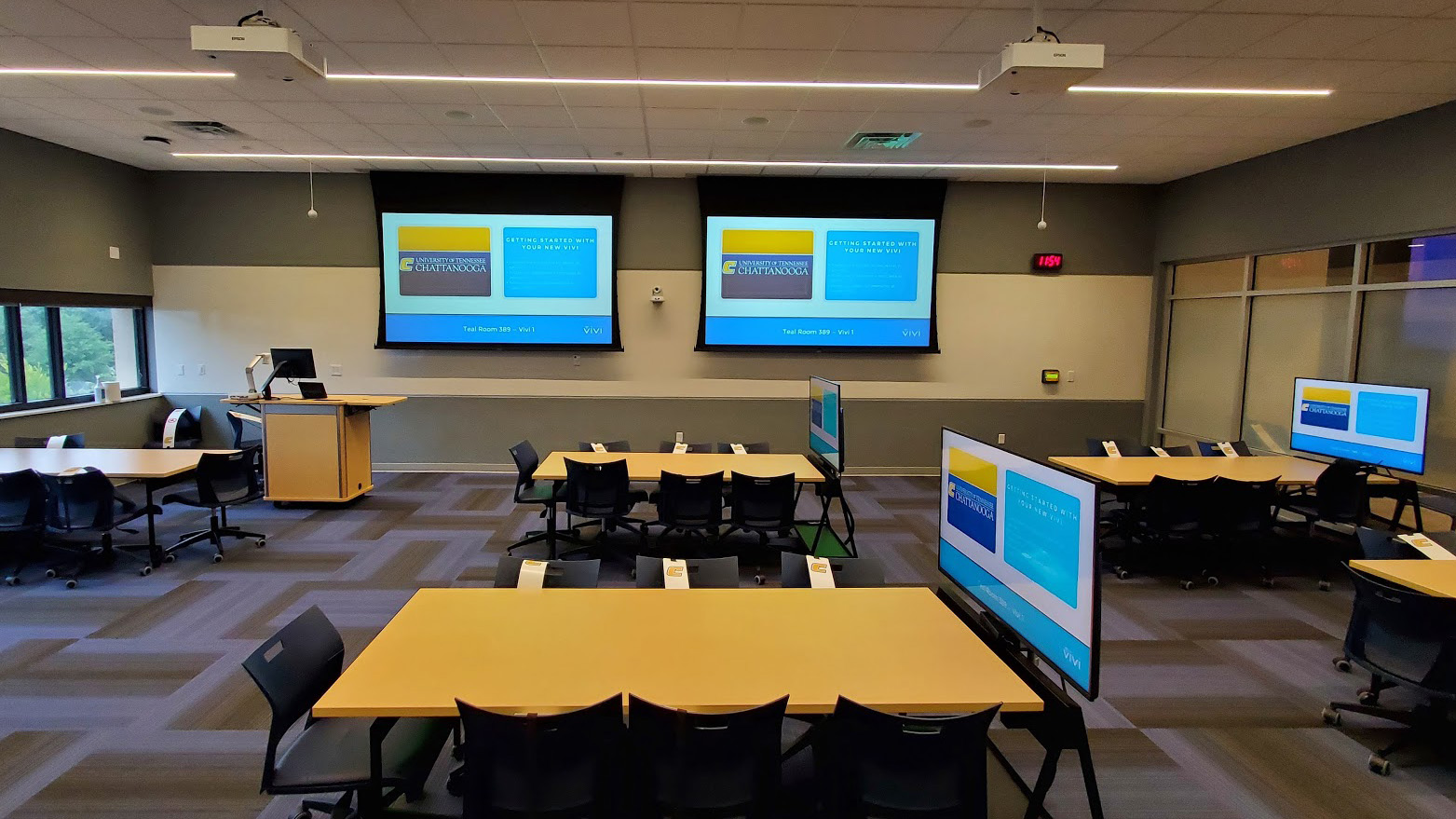High Expectations for Hybrid Education
A HyFlex strategy is designed to enrich student engagement and success in both the physical and digital realms.

As colleges and universities modeled various scenarios in a quest to stay solvent during the pandemic, adaptation became the guiding theme. Among the myriad of approaches considered, the HyFlex (hybrid-flexible) framework has proven to meet the demands of today while providing the agility to stay relevant long after COVID-19 fades.
A HyFlex strategy guarantees that every classroom exists in both the physical and digital realms, and students can inhabit both modalities seamlessly, with no difference in the richness of their learning experience. Adherents of hybrid models point out their equalizing effects for students with disabilities, adult learners, and international students. Its incorporation of mobile collaborative tools is another selling point.
[Moving to The Next Generation of Higher-Education Technology]
But can our higher-educational institutions, which have been equated with the brick-and-mortar physical campus for centuries, absorb these changes? How are AV/IT teams and instructional designers adapting to these shifting expectations? And what hardware, software, and network infrastructure solutions will help keep students on track?
Students Want Flexibility
A 2020 survey by Microsoft Education and the Economist Intelligence Unit found that while digital learning was already the inevitable direction for higher ed, COVID-19 has been a change accelerant, speeding up the process by 10 years or more. There has inevitably been some fallout from the swiftness of this change. More than 70 percent of faculty were “concerned” about their ability to deliver the same quality of instruction through online methods, and students and faculty alike cited adaptation to online learning as the most significant challenge during the pandemic.
However, research shows that these learning platforms are not going anywhere, and students don’t really want them to. The most recent Digital Learning Pulse survey, published in April 2021, found that 73 percent of students wanted the option to take some courses online, and 68 percent were interested in courses offered through a combination of in-person and online instruction.

Student interest in hybrid programs continues to grow, but what does the data reveal about their efficacy? A 2010 survey from the U.S Department of Education suggests that while students in online-only modalities perform modestly better than those on site, students in hybrid learning programs actually outperform their peers.
A daily selection of the top stories for AV integrators, resellers and consultants. Sign up below.
[How NYU Equipped Campus for HyFlex Education]
Career readiness is another benefit of the hybrid modality. The educational sector’s migration to HyFlex mirrors broader corporate trends, as more companies embrace remote and hybrid workflows.
Engineering Meets UX
AEngineering Meets UXccording to EDUCAUSE, hybrid learning, also referred to as "blended learning," combines traditional face-to-face classroom instruction with online learning. AV/IT integration leaders like CTSI know why hybrid learning is evolving.

“There's been a transition this past year from ‘hybrid’ learning to what is morphing into ‘HyFlex,’” observed Mike Wilson, director of engineering for CTSI. “Before the pandemic, you had a classic synchronous/real-time, in-person environment with the ability to bring in asynchronous or hybrid elements into the program. Now, through the pandemic and with the move to hybrid and now HyFlex, we see a major shift in both workflow and process, from the engineering perspective and the user perspective.”
[CTSI Acquires Systems Electronics]
Hyflex provides the instructional foundation, educational content, and technical capabilities to empower full collaboration among participants, regardless of whether they are—in person, synchronous, remote, or asynchronous. “HyFlex offers the ultimate in learning space flexibility,” said Pjotr van Baarle, global education lead for Kinly, an international provider of AV collaboration services and support.
To unlock the potential of synchronous sharing, the HyFlex shift requires more transparent, intuitive control that is integrated directly into the workflow and architecture of the classroom system. “We're leveraging transparent control with Microsoft Teams, Zoom, and larger UC [unified collaboration] platforms to also control the room and the whole academic environment,” Wilson said. “We cannot deploy systems that require extra training on the AV systems. We want people to just adopt it and use it instantly—a totally frictionless experience in their workflow or instruction.”
Multimodal and Inclusive
HyFlex also requires a cultural change. While the discussion tends to foreground technical requirements, attitude change is often the heavier lift. Lecture capture is nothing new, with systems like Mediasite in use for decades, but HyFlex is a different educational framework that gives students more agentive control of their learning. It offers various modal pathways from which students can choose.
But all stakeholders must be aligned to make it work. The traditional academic experience is built around synchronous learning, with students and the instructor in the room at the same time. The pedagogy, workflow, and technology must be reassessed and, in many cases, recalibrated to meet learning objectives. Within the facility, the shift to HyFlex requires an infrastructure transition from physical, point-to-point wired connections to a secure IP topology for 24/7 remote and cloud access.
Common problem: An instructor needs to connect a laptop or desktop computer to a flat-panel display or projector while teaching remote participants and on-site students using a mix of school-issued tech and bring your own device (BYOD). The reverse is also true: A professor needs to dial into a class via his laptop to lead a workshop with on-site students. The ever-growing list of possibilities is why the campus infrastructure must move to IP.
“AV-over-IP-based communication allows us to take the various sources and encode them and put them on the network,” said Wilson. “That allows us to share between classrooms and people, then use software-based tools like wireless presentation with active learning capabilities.”
Downstream Considerations
At the heart of the modern campus is a rock-solid IP infrastructure with an ample bandwidth network for collaboration, streaming, and high-resolution video sharing. 4K and 8K video, as well as VR/AR output, necessitate strong Wi-Fi networks, with extenders where needed. Students with unstable home Wi-Fi may need accommodations or additional tools; it is incumbent on the intuition to ensure equal access. Plus, data security and PII (personal identification and information) safety measures must be current to safeguard critical data.
HyFlex’s downstream implications for campus AV/IT teams are notable. Key video components include interactive displays, interactive whiteboards, projectors, and auto-tracking and auto-zooming cameras—all outfitted with AI and IP capabilities. 1 Beyond’s Automate VX, AutoTracker 3 cameras, and PTZ cameras, for example, can track instructors as they walk around a room and join with videoconferencing platforms to connect remote students.

With its wireless screen sharing solutions designed specifically for education, Vivi exemplifies how technology can help students personalize their learning journeys. “We empower teachers to help students get the most out of a lesson,” explained Natalie Mactier, CEO of Vivi. “With Vivi, a teacher can instantly share content to a classroom display and then can encourage active participation from every student. It’s all about richer student engagement and collaboration, and much more personalized learning.”
These benefits extend directly to hybrid learning applications. Vivi will soon debut its hybrid learning solution with its videoconferencing partners. With videoconferencing functionality embedded in the Vivi app, users just initiate Vivi in the classroom and the videoconference will automatically start. All students in the classroom have the same screen experience as students at home. Any content that's shared on the classroom display is also seamlessly shared on remote students’ devices.
[Executive Q&A: PPDS Offers Features and Functions]
PPDS, the company behind Philips Professional Displays, has also been a strong advocate in its support and development of HyFlex learning technology and solutions. Running on Android, its Philips T-Line interactive education display centers heavily on both physical and wireless collaboration, allowing students—whether inside a classroom or learning remotely—to access the display using their own personal connected device.
From an AV/IT perspective, IP-enabled video and cameras help keep Help Desk tickets down, because they can be configured once, then remotely managed thereafter. “When everything's on the network,” Wilson explained, “it makes it easier for us to transmit content around the room, campus, and push content to students on the go.”

Audio is also central to the HyFlex environment. Beam-forming microphone arrays are a “huge element of new system design,” said van Baarle. “This kind of audio enables us to steer microphone pickups to the appropriate locations within a room, pinpoint specific speakers, and make sure all students have the best audio quality, whether they are in the room or learning remotely. Every use case or classroom could be different, but with beam-forming microphones, we can provide the speech intelligibility to the far side of a hybrid environment.”
[AV/IT Team: Hybrid Learning Experience Simplified by Audio System Integration]
Other considerations include the traditional learning space design, which need to be revised to work with hybrid setups. Movable desks, pods, and reconfigurable zones are supplanting affixed desks. Zoom, Microsoft Teams , and other videoconferencing platforms are central to today’s hybrid learning programs—and software-based learning management systems, such as Canvas and Blackboard, must be agile enough to tie in these platforms as well as eBooks, audio, and other UC solutions.
To assist educational clients with budget constraints and keep technology current, CTSI offers a subscription services model. The service model offers flexibility with financing, moving the line item from capital expense (CapEx) to operational expense (OpEx). Instead of waiting for a large chunk of capital budget to be allocated, AV as a Service (AVaaS) enables educators to accelerate HyFlex technology into the learning environment, while ensuring the systems operate at peak performance with managed service. Also included is an ongoing technology refresh program, ensuring the systems adapt as new technology becomes available.
Margot Douaihy, Ph.D., is a lecturer at Franklin Pierce University.

